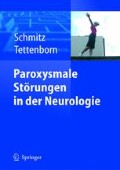Access this chapter
Tax calculation will be finalised at checkout
Purchases are for personal use only
Preview
Unable to display preview. Download preview PDF.
Literatur
Aicardi J, Chevrie JJ (1982) Atypical benign partial epilepsy of childhood, Dev Med Child Neurol 24:281–292
Aicardi J, Levy G (1992) Clinical and electroencephalographic symptomatology of the »genuine« Lennox-Gastaut syndrome and its differentiation from other forms of epilepsy of early childhood, Epilepsy Res Suppl 6:185–193
Berkovic SF, Carpenter S, Evans A et al. (1989) Myoclonus epilepsy and ragged-red fibres (MERRF). 1. A clinical, pathological, biochemical, magnetic resonance spectrographic and positron emission tomographic study. Brain 112: 1231–1260
Berkovic SF, Cochius J, Andermann E, Andermann F (1993) Progressive myoclonus epilepsies: clinical and genetic aspects. Epilepsia 34[Suppl 3]:S19–S30
Bhatia KP, Brown P, Gregory R et al. (1995) Progressive myoclonic ataxia associated with coeliac disease — the myoclonus is of cortical origin, but the pathology is in the cerebellum. Brain 118:1087–1093
Blume WT (1987) Lennox-Gastaut syndrome. In: Lüders H, Lesser RP, Swash M (eds) Epilepsy: Electroclinical syndromes. Springer, New York, pp 73–92
Brown P (2002) Neurophysiology of the startle syndrome and hyperekplexia. Adv Neurol 89:153–159
Brown P, Thompson PD (2001) Electrophysiological aids to the diagnosis of psychogenic jerks, spasms, and tremor. Mov Disord 16:595–599
Caviness JN (2002) Epidemiology of myoclonus. Adv Neurol 89:19–22
Caviness JN, Alving LI, Maraganore DM et al. (1999) The incidence and prevalence of myoclonus in Olmsted County, Minnesota. Mayo Clin Proc 74:565–569
Celesia GG, Grigg MM, Ross E (1988) Generalized status myoclonicus in acute anoxic and toxic-metabolic encephalopathies. Arch Neurol 45:781–784
Cockerell OC, Rothwell J, Thompson PD, Marsden CD, Shorvon SD (1996) Clinical and physiological features of epilepsia partialis continua. Cases ascertained in the UK. Brain 119:393–407
Commission on Classification and Terminology of the International League Against Epilepsy (1989) A revised proposal for the classification of epilepsy and epileptic syndromes. Epilepsia 30:389–399
Cooper JD (2003) Progress towards understanding the neurobiology of Batten disease or neuronal ceroid lipofuscinosis. Curr Opin Neurol 16:121–128
Deuschl G, Wilms H (2002) Palatal tremor: the clinical spectrum and physiology of a rhythmic movement disorder. Adv Neurol 89:115–130
Doose H (1992) Myoclonic-astatic epilepsy. Epilepsy Res [Suppl 6]:163–168
Doose H (1992) Myoclonic-astatic epilepsy [Review]. Epilepsy Research [Suppl 6]:163–168
Frucht SJ (2002) The clinical challenge of posthypoxic myoclonus. Adv Neurol 89:85–88
Frucht SJ, Louis ED, Chuang C, Fahn S (2001) A pilot tolerability and efficacy study of levetiracetam in patients with chronic myoclonus. Neurology 57:1112–1114
Fukuhara N (1991) MERRF: a clinicopathological study. Relationships between myoclonus epilepsies and mitochondrial myopathies. Rev Neurol (Paris) 147:476–469
Hallett M (2002) Neurophysiology of brainstem myoclonus. Adv Neurol 89:99–102
Krumholz A, Stern BJ, Weiss HD (1988) Outcome from coma after cardiopulmonary resuscitation: Relation to seizures and myoclonus. Neurology 38:401–405
Lance JW (1986) Action myoclonus, Ramsay Hunt syndrome, and other cerebellar myoclonic syndromes. Adv Neurol 43:33–55
Lehesjoki AE (2002) Clinical features and genetics of Unverricht-Lundborg disease. Adv Neurol 89:193–197
Lempert T, Bauer M, Schmidt D (1994) Syncope: a videometric analysis of 56 episodes of transient cerebral hypoxia. Ann Neurol 36:233–237
Marsden CD, Hallett M, Fahn S (1981) The nosology and pathophysiology of myoclonus. In: Marsden CD, Fahn S (eds) Neurology 2 — Movement disorders. Butterworth Scientific, London, pp 196–248
Marsden CD, Harding AE, Obeso JA, Lu CS (1990) Progressive myoclonic ataxia (The Ramsay Hunt syndrome). Arch Neurol 47:1121–1125
Minassian BA (2002) Progressive myoclonus epilepsy with polyglucosan bodies: Lafora disease. Adv Neurol 89:199–210
Pranzatelli MR, Nadi NS (1995) Mechanism of action of antiepileptic and antimyoclonic drugs. Adv Neurol 67:329–360
Rothwell JC (2002) Pathophysiology of spinal myoclonus. Adv Neurol 89:137–144
Shiang R, Ryan SG, Zhu YZ (1993) Mutations in the alpha1 subunit of the inhibitory glycine receptor cause the dominant neurologic disorder, hyperekplexia. Nat Genet 5: 351–357
Shibasaki H (2002) Physiology of negative myoclonus. Adv Neurol 89:103–113
Tassinari CA, Lyagoubi S, Santos V, Gambarelli F, Roger J, Dravet C, Gastaut H (1970) Studies on spike and wave discharges in man. II. Clinical and EEG aspects of myoclonic absences. Electroencephalogr Clin Neurophysiol 29:103
Thomas JE, Reagan TJ, Klass DW (1977) Epilepsia partialis continua. A review of 32 cases. Arch Neurol 34:266–275
Thomas PK, Abrams JD, Swallow D, Stewart G (1979) Sialidosis type 1: cherry red spot-myoclonus syndrome with sialidase deficiency and altered electrophoretic mobilities of some enzymes known to be glycoproteins. 1. Clinical findings. J Neurol Neurosurg Psychiatry 42:873–880
Thompson PD (2002) Neurodegenerative causes of myoclonus. Adv Neurol 89:31–34
Ugawa Y, Hanajima R, Okabe S, Yuasa K (2002) Neurophysiology of cortical positive myoclonus. Adv Neurol 89:89–97
Van Cott AC, Blatt I, Brenner RP (1996) Stimulus-sensitive seizures in postanoxic coma. Epilepsia 37:868–874
Werhahn KJ, Brown P, Thompson PD, Marsden CD (1997) The clinical features and prognosis of chronic post hypoxic myoclonus. Mov Disord 12:216–220
Author information
Authors and Affiliations
Editor information
Editors and Affiliations
Rights and permissions
Copyright information
© 2005 Springer Medizin Verlag Heidelberg
About this chapter
Cite this chapter
Werhahn, K.J. (2005). Myoklonien. In: Schmitz, B., Tettenborn, B. (eds) Paroxysmale Störungen in der Neurologie. Springer, Berlin, Heidelberg. https://doi.org/10.1007/3-540-26665-8_11
Download citation
DOI: https://doi.org/10.1007/3-540-26665-8_11
Publisher Name: Springer, Berlin, Heidelberg
Print ISBN: 978-3-540-40789-8
Online ISBN: 978-3-540-26665-5
eBook Packages: Medicine (German Language)

